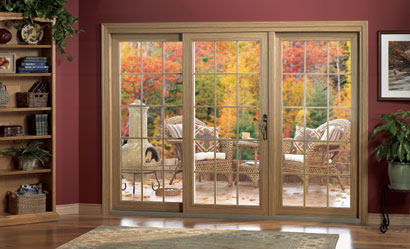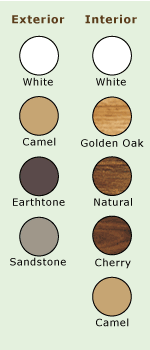- Constructed of heavy-duty, maintenance free New Generation
Vinyl
- Pinch Fusion-Welded patio door frame
panels to ensure a tight seal essentially creating one piece units
- Insulated Tempered Glass featuring the Intercept Glass System which reduces the possibility of condensation so much
that they warrant the glass for life against seal failures.
- R-Core insulated frames to ensure proper performance.
- Multi-point locking hardware is standard on all Seabrooke Patio Doors
- Numerous glass options to further improve the energy efficiency of the glass units.
- Optional Grids in various patterns to further enhance the look of your new door.
Also the grids are in-between the panes of glass so cleaning is a breeze!
- Multi-point roller system ensures that the panels will roll with the greatest of ease.
- Heavy-duty extruded screen frame to ensure a long lasting and easy to use panel.
- Locking screen for child safety.
- Optional foot latch for added safety and venting capabilities.
- Numerous color options such as woodgrain finishes and two-tone color (in/out tones)
- Optional internal blinds and shades
- Optional contoured grids (with woodgrain finishes also)
- Optional V-Groove Etched Glass in numerous patterns
- Energy Star Qualified Product
- Limited
Lifetime Warranty that is also transferrable to next homeowner!!! Ask for details
- and many many many more reasons to choose Seabrooke Patio Doors!!!!
Here’s some of the advanced
window technology you can expect from Seabrooke windows: | | | | | | | | | | | | The performance of Seabrooke™ windows has been recognized by the following independent industry organizations: | | | | |
 |
 |

|
| 9 foot / 3 panel patio door shown with woodgrain interior, williamsburg grids, and brass handle |
 - Vinyl vs. wood or aluminum
Vinyl is a better insulator than wood or
aluminum. It doesn’t conduct heat or cold like aluminum – a major source of lost heating/cooling energy. And,
it doesn’t swell and shrink like wood when temperatures change. It never needs painting and won’t show scratches,
unlike aluminum or wood windows.
> Today, over 75% of replacement windows are vinyl*. But just because a window
is made of vinyl doesn’t mean it is a superior product. The design, engineering and manufacturing of the window all
help distinguish a poor window from a superior window.
> *Sabre Report 2004.
- R-value
The thing to remember when considering an R-value is that the higher the R-value number is, the greater the insulation value.
As with any measure of energy efficiency, it’s not so much what’s considered acceptable, as what is acceptable
to you. Insulation in the sash and/or mainframe of a vinyl window can significantly up the R-value of a window frame. Check
for the availability of this feature when assessing a window’s energy efficiency.
Glass is rated in R-values
also – the same used to rate window frames. The type of glass, thickness, number of panes, distance between the panes,
as well as, the manner in which panes are connected, all affect the R-value performance of the window.
- U-factor
This is a standard measure of heat transfer through an entire window unit. The methods for measuring U-factor ratings were
developed by the National Fenestration Rating Council (NFRC) at the request of the U.S. Department of Energy and the Federal
Trade Commission.
The lower the U-factor the better the window’s insulating ability. A window’s U-factor
is the reciprocal of its R-factor. They both measure its insulating ability. Look for windows with low U-factors and high
R-values.
- Low-E glass
There are two major types of Low-E (the ‘E’ stands
for emissivity) glass: hard-coat (pyrolitic) and vacuum-deposition (sputter). Both types block radiant heat, keeping summer’s
heat outside and winter’s heat inside. And both block the sun’s rays to some degree.
But windows made
with multi-layer, vacuum deposition (sputter coat) Low-E glass have much better visual clarity. With this type of glass you
have very little haze factor which provides almost the same clarity as clear ‘uncoated’ glass.
- Argon
or Krypton gas
Air between the panes of insulating gas can be replaced with high-density Argon or Krypton gas.
This process provides windows with a both increased energy efficiency and increasing sound deadening properties. Both Argon
and Krypton are safe, odorless, colorless gases that occur naturally in our atmosphere. But, because of their density, heat
and cold do not pass through these gases as easily as through air. When Argon or Krypton gas is used in an insulated glass
system with a vacuum deposition (sputter) coat Low E glass, it creates one of the most energy efficient windows you can buy.
- Noise reduction
Some of the same features that make a window more energy efficient
can also help to significantly cut down on noise transmission from outdoors.
- Wood grain finishes
Today’s better interior wood grain finishes are designed for a lifetime of maintenance-free beauty. They’ve
proven themselves over time to resist fading, chipping, peeling and blistering.
- Designer or decorative
glass
Glass styles play an important role in the appearance and curb appeal of a home. Styles and selections
will vary with each manufacturer, but the more styles that are available to choose from, the better the protection and enhancement
of the value of a home, whatever its architectural style.
 |






